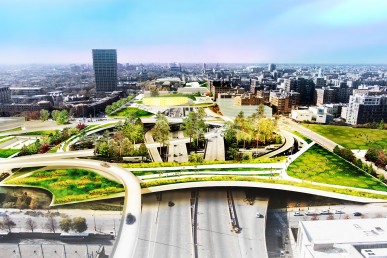UIC proposal for Obama Library creates cultural, civic corridor
Not just a library, but a cultural and civic corridor extending from the lakefront Museum Campus through UIC to North Lawndale: that’s the vision driving UIC’s bid to host the Obama Presidential Library.
The proposal was developed by the UIC Obama Presidential Library and Museum Steering Committee and the North Lawndale Presidential Library Committee.
“The occasion of establishing a presidential library should be more than the act of awarding a trophy to a specific site; it has the potential to change the city by leveling the playing field,” begins the proposal.
“The goal for the library, along with its allied public and private investment, would be to irrigate this zone with new potential, stimulating economic and infrastructure development as well as providing a larger case study in how to reclaim and rehabilitate the 21st-century city.”
UIC proposes optimal use of two very different sites to serve both community and academic purposes. Harrison Field, at the northwest corner of Harrison and Halsted streets on the UIC campus, would be the academic site. A 23-acre, vacant, city-owned lot in North Lawndale, bounded by Roosevelt Road and Kostner, Kildare and Fifth avenues, would be the community site.

One of the proposal’s most dramatic ideas is to build green spaces above selected parts of the Eisenhower Expressway.
The North Lawndale parcel would house the library, museum and acres of new parkland. Mayor Rahm Emanuel, in a Nov. 21 letter to the Barack Obama Foundation, supported the conveyance of the land and the reopening of the CTA Blue Line Kostner station if the location is chosen. The Steans Family Foundation, which concentrates its philanthropic grants in North Lawndale, announced a $5 million pledge to support the site.
At Harrison Field, UIC proposes a visitors’ center and a new “O-4 Institute” for academic-civic collaboration, named for “optimism, outreach, opportunity and one world, extending to the four corners of the world,” in keeping with the Obama policy agenda.
The O-4 Institute would host fellowships for academics, and junior fellowships for high school students. UIC faculty and students would work with the institute on issues like affordable housing, workforce development, literacy, and access to health care. The site, overlooking the downtown skyline and the Jane Byrne Interchange, is adjacent to the UIC-Halsted CTA station and at the hub of the city’s and nation’s transportation network.
The proposal notes that the east-west corridor sparked by the library and institute would complement Chicago’s north-south lakefront axis. A video accompanying the proposal recounts historic events along this east-west corridor: Daniel Burnham’s 1909 Plan of Chicago, which envisioned a civic center at Congress and Halsted, Jane Addams’ Hull House settlement, and Martin Luther King Jr.’s northern outpost of the Freedom Movement in North Lawndale.
The proposal committee recommends new public green spaces to mark the corridor. The most dramatic idea is to build green spaces above selected parts of the Eisenhower Expressway around the visitors’ center and the O-4 Institute.
“More than a gateway, this destination acts as an urban living room that establishes new relations within the campus, as well as between the campus and its surrounding communities,” the proposal states.
The proposal envisions forming a new town square in North Lawndale, with the library and museum as a hub to generate commercial and residential development. The defunct “Sears line” viaduct that enters the middle of the site from the east would set up a campus spine along a new bike trail and pedestrian corridor.
A proposed bus rapid transit line along Roosevelt Road would extend the corridor to the Museum Campus on the lakefront. Along the route, the proposal suggests, “these developments would contribute to a re-densification and diversification of the residential grid, the expansion of Chicago Park District land and recreational facilities, and the provision of a civic destination accessible to a wide variety of communities.”
UIC is one of four finalists for the future library and museum, along with University of Chicago, Columbia University and the University of Hawaii. The Obama Foundation will share its recommendations with the president and first lady, who will make the final decision in the next several months.
The Obama Presidential Library will be part of the presidential library system, which includes 13 libraries in the National Archives and Records Administration. It will preserve and make available to the public the papers, records and other historical materials that document the lives of the president, his family, associates and administration. The library would operate through an endowment provided by the foundation and federal funding.
Videography by Sonya Booth
